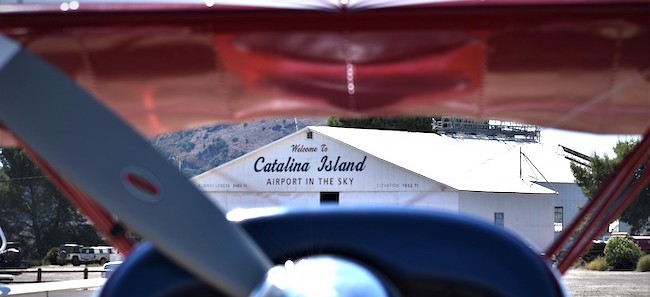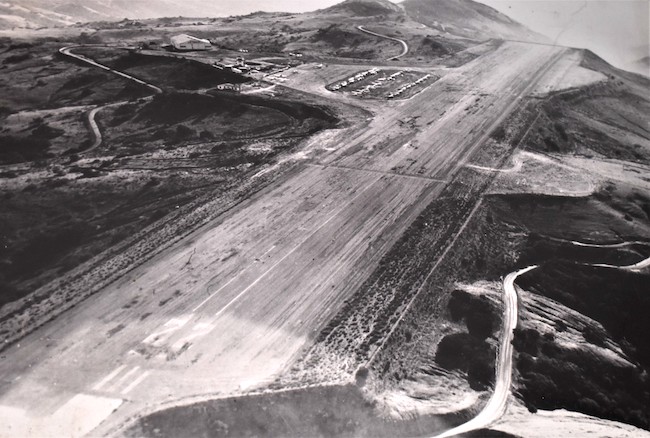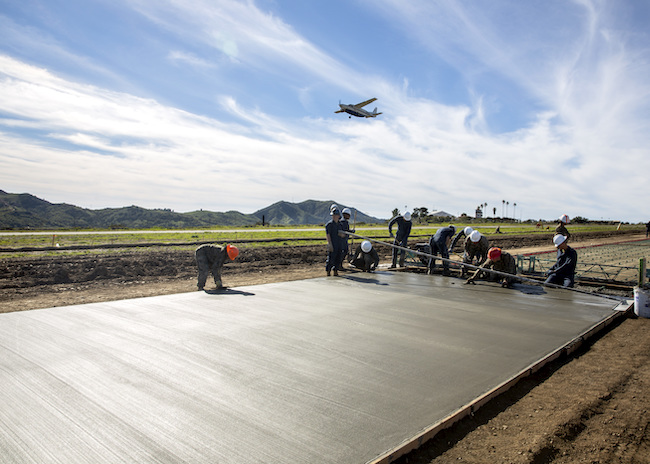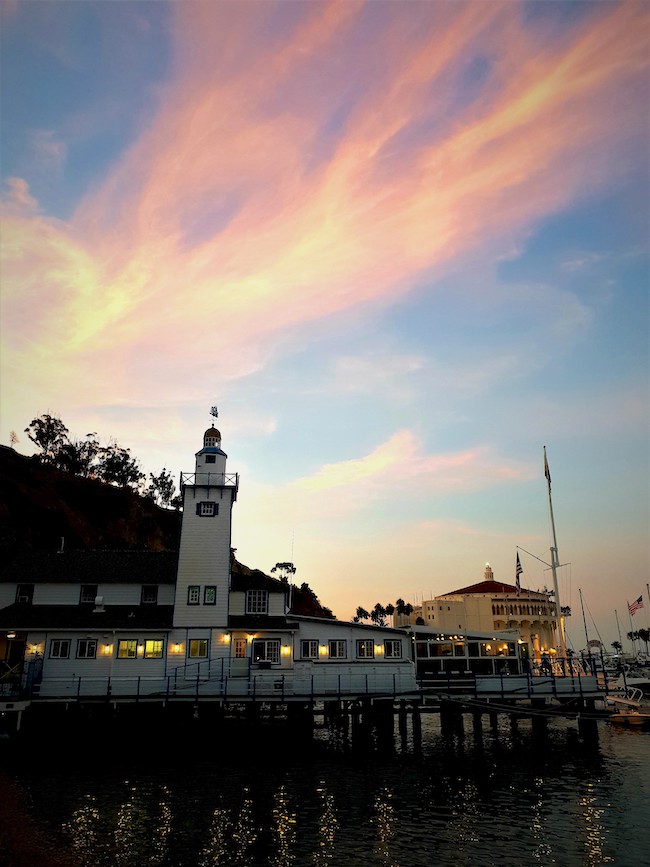 |
ISSUE 605 - October 2019
Over 9,000 Total Ads Listed
1,000+ NEW Ads Per Week |
| Let's Fly To The Airport In The Sky |
|
| Catalina Airport on Catalina Island. |
|
When I purchased my Great Lakes biplane, I knew that I was unleashing a world of opportunities and unique experiences. Of course, Catalina Island was on my bucket list of places I must visit, as it is just off the California coast. It also seemed fitting that I could commemorate my first landing at the Airport in the Sky with a personal achievement of attaining 250 hours of flight time.
However, first, let me clear this up; Catalina Airport is a private airport and does not receive any government funding. Construction of the airport started in 1941, designed to accommodate the Wrigley family's DC-3 (later, United Airlines offered service there also in a DC-3), and opened to air traffic on June 27, 1946 (though it did spend some time during the war closed for strategic purposes). In 1972 the Catalina Island Conservancy was formed by the Wrigley family, and on February 15, 1975 the Conservancy was deeded 42,135 acres to manage the natural resources of the Island which included the airport. Jets have been dissuaded from landing, especially after the 1984 Learjet crash that killed six people. The airport does run on limited hours which vary from summer to winter. There are no mechanic services available and that includes fuel. You did get that? No fuel. No mechanic on duty. The last increase in landing fees was in 2012, in recent years the airport has struggled to generate more funds than expenses, so has always had to rely upon additional private donor support to remain operational.
The first flight to Catalina was on May 11th, 1912 by Glenn L. Martin in his home-built sea biplane. He flew from Newport Harbor to Avalon Bay with a substantial marine layer. This was the longest flight over water at the time (ten miles longer than the English Channel crossing) and the first water takeoff and landing in the same flight.
By 1922, regularly scheduled service was being provided by flying boats. In 1931 Wrigley established a company that operated a daily service to the island. Hamilton Beach was chosen as the location for the new Catalina Airport. A concrete ramp and even a turntable were installed allowing the amphibious planes to completely exit the water, unload and load, then be turned around in minimal time. This was the original location of the Catalina Island hangar that you see today at the airport. This hangar was carefully taken down and moved to the Airport in the Sky when operations ceased in Hamilton Bay shortly after the bombing of Pearl Harbor.
A suitable place had been sought on the island to build a land-based terminal. They state that a lot of research was done to locate a suitable site (which by coincidence was very, very close to El Rancho Escondido - a Wrigley Family private estate). Construction began ten miles northwest of Avalon in 1940 to build the Buffalo Springs Airport (later renamed the Airport in the Sky). The runway was formed by removing the tops of two mountains and filling in the adjacent canyon.
|
|
| The airport under construction. |
|
However, with the outbreak of World War II, the airport was leased to the US Army that then put obstructions on the runway preventing enemy aircraft from landing there (the whole island was closed to tourists from 1942 to 1945). The airport was returned to the Catalina Island Company in January of 1946, and the airport was officially opened on June 27, 1946. After receiving so many requests to land, the airport was opened for general public use October 24, 1959.
|
|
| From the Cessna 172 to the Eurocopter EC120B; both are welcome at the Airport in the Sky. |
|
Recently the airport was able to undergo a much-needed overhaul of the runway. I have heard the stories about how pilots would not only have to negotiate the approach to the runway (which has been related to landing on an aircraft carrier because of the 1,500-foot drop at the beginning of the runway and another sharp drop off at the other end) and then around all the potholes that were strewn about. The runway had deteriorated so far that there were rumors of it having to close, even though $250,000 was spent annually trying to maintain it.
A solution was found in an amazing collaboration between the Catalina Island Conservancy and US Marine Corps and US Navy, comprising 1 Marine Expeditionary Force based at Camp Pendleton, the 3rd Marine Aircraft Wing from Marine Corps Air Station, Marine Wing Support Squadron 373, Naval Construction Group ONE, FIRST Naval Construction Regiment, and Naval Mobile Construction Battalion 25. The airport needed a new runway, and as part of the Department of Defense's Innovative Readiness Program, they needed a project. The conservancy raised funds from generous donors to cover material costs, whilst the military provided the muscle to get the job done.
|
|
| Photo credit U.S. Marine Corps, Lance Cpl. Juan Anaya |
|
| Photo credit U.S. Marine Corps, Lance Cpl. Juan Anaya |
|
With over 100 marines and sailors camping out right next to the runway from December 2018, to its reopening May 3, 2019, the Airport in the Sky can now boast a nice new concrete runway.
|
|
| Prints in the concrete pictured; Kellie Johnson, Chair of the Board of the Catalina Island Conservancy and President/CEO of ACE Clearwater. Gary Johnson, Vice President of ACE Clearwater. Their dog Joey. Conservancy staff Justin Bollum, Lenny Altherr, and Dennis Raymond. And a very appropriate boot print from USMC Captain Nicole Stockham. |
|
Yes, the landing fees have increased, but this is a private airport which now has a smooth and safe runway to land on. The cost of the runway was $5 million of which the conservancy has raised $4.6 million to date. Substantial donations were made by ACE Clearwater Enterprises, the Wrigley/ Rusack family, and aviation legend Clay Lacy.
So, what does it take to fly a classic biplane taildragger to the Airport in the Sky?
I will be the first to agree that this is probably not the best place for a complete rookie to get his boots dirty. However, saying that, it is not as bad as people often make out (especially now) so long as you follow some basic rules. I did some practicing at Fallbrook Airpark (L18) on the advice of Marc Lee, who has flown a Great Lakes to Catalina Island many times. Fallbrook Airpark has similar characteristics to Catalina but is a lot shorter; if you can land comfortably at Fallbrook, Catalina will be no problem. (If you do end up at Fallbrook practicing, stop in and introduce yourself to the folks there. They are a pretty friendly bunch.)
|
|
| Wheels on the ground (Photo by Dennis Raymond) |
- Take it seriously, plan ahead, do your homework and make sure you know all that you can about the Airport in the Sky before you leave.
- Do you have enough fuel to get there and back? Make sure you have a good reserve. Remember there is no fuel or mechanic available. Extra oil?
- What is the weather like? Good at departure and destination? Give Catalina tower a call and ask them. In fact it is always a good idea to call them in advance: (310) 510-0143.
- How is the health of the plane you will be flying? Maintenance good? I had Aeromechanix at KMYF give my Great Lakes a good going over before I did this trip. I may be over cautious, but I place safety at the top of my list.
|
|
| Alan from Aeromechanix checking over the Lycoming AEIO 360 prior to the trip. Safety first. |
- Plan ahead. What if you have to ditch? Do you have flotation devices? I purchased two lightweight lifejackets from Aircraft Spruce. What about a Personal Locator Beacon?
- Try to get flight following, and/or file a flight plan. However, be aware that the cellphone reception is not that good (if at all) at the airport, and there is no Wi-Fi available for those of us who use stuff like ForeFlight (although they have said they are looking into it for the future).
- Be on CTAF (122.7) at ten miles, start making your call outs, and you might as well climb to pattern altitude - 2,602 ft.
- Fly the pattern (Runway 22 is right traffic pattern). This way you will be able to get eyes on the runway and orientate yourself properly.
- Do NOT attempt a straight in approach. There are no markers or signs like at your home airport. The only thing you will have to guide you will be your altimeter. Save yourself the trouble and get in the pattern first.
- You do not need a higher and faster approach than at your home airport. Be wary of a downdraft right at the beginning of the runway but there is no need to come in hot and high. That will just make good cause for an embarrassing go around.
- Once you have cleared the runway, ask the tower where they want you to park; do not presume you know where to go. You would call for taxi instructions at a towered airport, be courteous and do so here.
- Bring your own chocks and tie-down ropes, as it can get windy, especially if you plan to stay the night. (And why would you not want to stay the evening in Avalon?)
So, is it worth the flight?
Of course you need to stop by the DC3 restaurant that is located at the airport (famous for its buffalo burgers, and giant, homemade cookies - sit on the patio and enjoy the wonderful view of the islands interior), but with regular shuttle rides and taxis to Avalon (mountain bikes too, if you are up to the challenge), this could just be the start to your adventure.
|
|
| The famous buffalo burger. This one I actually ate - for editorial purpose of course! |
|
Pilots should consider the airport not just as a destination but also as a gateway to the amazing resources that are available on Catalina. Yes, of course there are the hotels, bars, and restaurants in Avalon (see if you can get some "Buffalo Milk"), but also the ziplining, parasailing, spas, boat rentals, hiking, boating, camping, mountain biking, tours, and scuba diving. Or take in a movie or concert at the casino (Italian for meeting place, not gambling)!
Over the years, Catalina has played host to a dizzying array of guests and was even the spring training camp for the Chicago Cubs for 30 years (who were also owned by Wrigley). It was one of the playgrounds for the Hollywood stars such as Charlie Chaplin, John Wayne, Marilyn Monroe, Humphrey Bogart, and Errol Flynn. Even Sir Winston Churchill was a guest at the exclusive Tuna Club in 1929.
Perhaps, though, you may not get into the exclusive Tuna Club; you may have better luck with the Marlin Club, the oldest watering hole on Catalina, built by merchant marines during World War II - probably have way more fun there too.
|
|
| Another amazing sunset in Avalon Bay. |
|
| The exclusive Tuna Club in the foreground with the Casino behind. |
|
Wrigley himself said, "While my motive in purchasing the island is largely a romantic one, I am going to leave no stone unturned to make it a refuge from worry and work for rich and poor." And in our fast-paced society that must be appealing to each and every one of us, stepping from the hustle and bustle of modern life into the Mediterranean-style island city that is hidden in plain view just off the California coast.
Yes, you can catch the ferry there, but you are a pilot ... Use all of the privileges that affords you.
|
|
| Ready to head back to San Diego, ready to plan a return trip to Catalina Island (Photo by Dennis Raymond) |
|
Fly. Go. Do. Experience. Enjoy.
Say hi to Justin and Dennis; they run the show out there, and I am grateful for their hospitality.
When you leave ... make sure you get clearance before you depart, as you cannot see the end of the runway. Catalina is one of the few airports that you can actually descend after takeoff once you have cleared the length of the runway. Yes, it is a pretty unique place, and yes, I will be going back.
|
|
| Back at KMYF ... mission accomplished. |
|
| Come fly with me to Catalina. 360 video in time-lapse. |
|
| Catalina departure and return to San Diego from the underside. 360 video in time-lapse. |
|
| |
Visit www.barnstormers.com -
post an ad to be viewed by more than 1,000,000 visitors per month.
Over 20 years bringing more online buyers and sellers together than any other aviation marketplace.
Don't just advertise. Get RESULTS with Barnstormers.com. Check out
the Testimonials |
| Registered Copyright © 1995-2019 barnstormers.com All Rights Reserved. |
 |
|

















